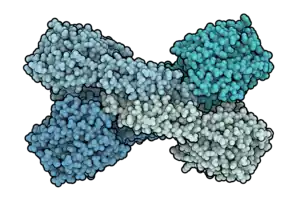Glucarpidase
 PDB: 1CG2 | |
| Names | |
|---|---|
| Trade names | Voraxaze |
IUPAC name
| |
| Clinical data | |
| Drug class | Enzyme[1] |
| Main uses | Methotrexate toxicity due to impaired kidney function[1] |
| Side effects | Numbness, flushing, nausea, low blood pressure, headache[1] |
| WHO AWaRe | UnlinkedWikibase error: ⧼unlinkedwikibase-error-statements-entity-not-set⧽ |
| Routes of use | IV |
| External links | |
| AHFS/Drugs.com | Monograph |
| MedlinePlus | a613009 |
| Legal | |
| Legal status |
|
| Chemical and physical data | |
| Formula | C1950H3157N543O599S7 (monomer) |
| Molar mass | 44017.33 g·mol−1 |
Glucarpidase, sold under the brand name Voraxaze, is a medication used to treat toxicity due to methotrexate (defined as > 1 micromol/L) due to impaired kidney function.[1] It is used together with leucovorin.[1] It is given by injection into a vein.[1] Effects are significant within 15 minutes and last for about a week.[1]
Common side effects include numbness, flushing, nausea, low blood pressure, and headache.[1] Other side effects may include anaphylaxis.[1] Safety in pregnancy is unclear.[1] It is an enzyme that inactivates methotrexate.[1]
Glucarpidase was approved for medical use in the United States in 2012.[1] While it is available as an orphan medication in the United Kingdom and Europe, it is not approved as of 2021.[2] In the United States a vial of 1,000 units costs about 35,500 USD as of 2021.[3]
Medical uses
Because this agent reduces systemic levels of methotrexate and could therefore interfere with efficacy, it is not recommended for use in people with normal or only slightly impaired kidney function or in whom serum levels are normal. The main antidote for methotrexate overdoses prior to the approval of this drug were high doses of folinic acid. However, this agent was not always sufficient at preventing kidney failure due to methotrexate. Glucarpidase also degrades folinic acid so the two should not be used together (within two hours of one another).
One case series in children has found that high-dose methotrexate therapy can be resumed after an instance of methotrexate-induced acute kidney injury successfully treated with glucarpidase.[4]
Chemistry
Glucarpidase, a recombinant form of the bacterial enzyme carboxypeptidase G2 converts methotrexate into glutamate and 2,4-diamino-N(10)-methylpteroic acid. These are generally much less toxic and are excreted largely by the liver.[5]
References
- 1 2 3 4 5 6 7 8 9 10 11 12 "Glucarpidase Monograph for Professionals". Drugs.com. Archived from the original on 15 May 2016. Retrieved 3 December 2021.
- ↑ "Glucarpidase". SPS - Specialist Pharmacy Service. 15 November 2021. Archived from the original on 4 December 2021. Retrieved 3 December 2021.
- ↑ "Voraxaze Prices, Coupons & Patient Assistance Programs". Drugs.com. Archived from the original on 19 April 2021. Retrieved 3 December 2021.
- ↑ Christensen AM, Pauley JL, Molinelli AR, Panetta JC, Ward DA, Stewart CF, et al. (September 2012). "Resumption of high-dose methotrexate after acute kidney injury and glucarpidase use in pediatric oncology patients". Cancer. 118 (17): 4321–30. doi:10.1002/cncr.27378. PMC 3713608. PMID 22252903.
- ↑ Green JM (2012). "Glucarpidase to combat toxic levels of methotrexate in patients". Therapeutics and Clinical Risk Management. 8: 403–13. doi:10.2147/TCRM.S30135. PMC 3511185. PMID 23209370.
External links
| Identifiers: |
|
|---|
- Original FDA approval of glucarpidase Archived 2017-01-18 at the Wayback Machine